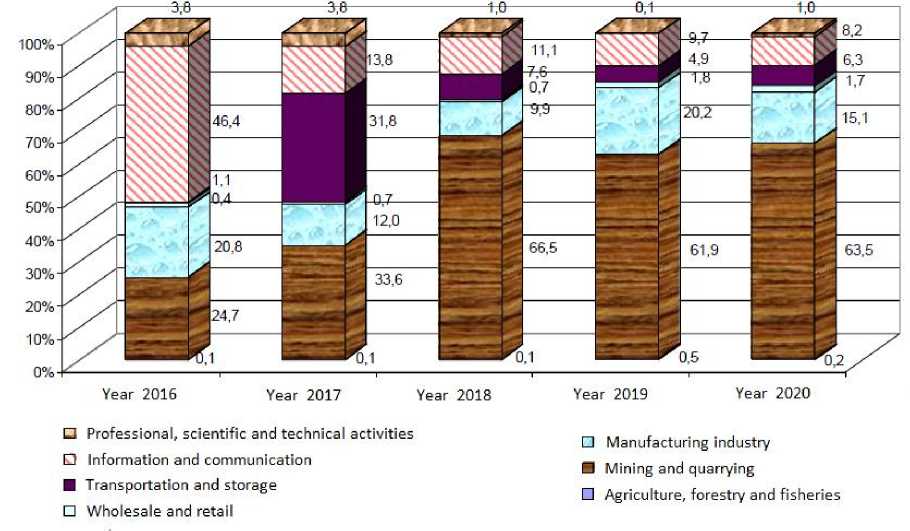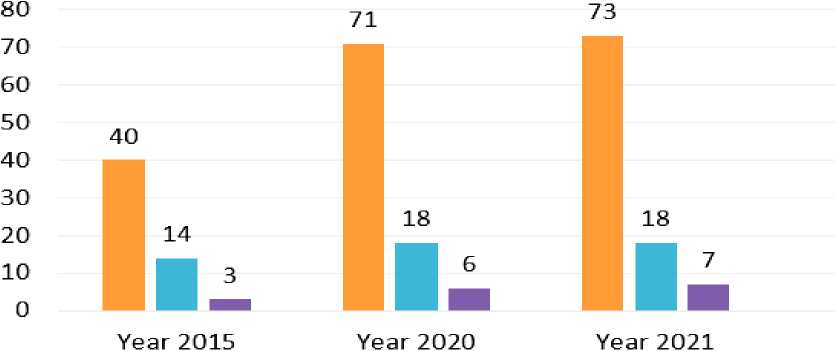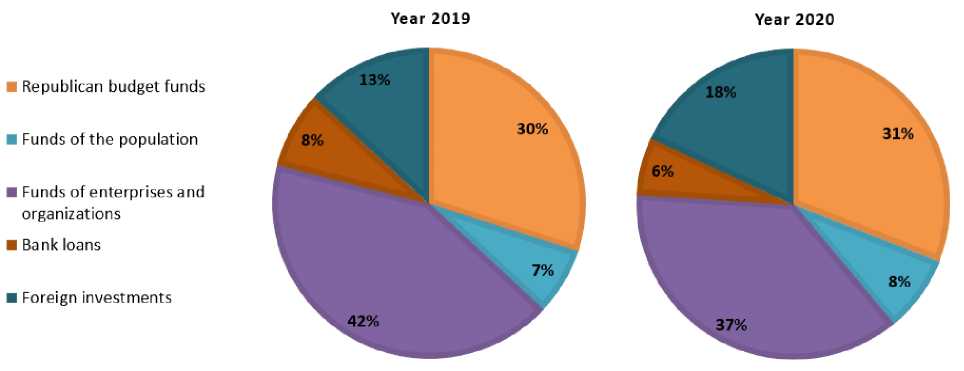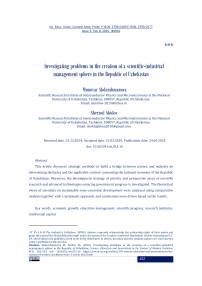Investigating problems in the creation of a scientific-industrial management sphere in the Republic of Uzbekistan
Автор: Abdurahmanova M., Abidov Sh.
Журнал: Science, Education and Innovations in the Context of Modern Problems @imcra
Статья в выпуске: 3 vol.8, 2025 года.
Бесплатный доступ
This article discusses strategic methods to build a bridge between science and industry by determining obstacles and the applicable content concerning the national economy of the Republic of Uzbekistan. Moreover, the development strategy of priority and perspective areas of scientific research and advanced technologies ensuring government progress is investigated. The theoretical views of scientists on sustainable socio-economic development were analyzed using comparative analysis together with a systematic approach, and conclusions were drawn based on the results.
Economic growth, education management, scientific progress, research institutes, intellectual capital
Короткий адрес: https://sciup.org/16010491
IDR: 16010491 | DOI: 10.56334/sei/8.3.16
Текст научной статьи Investigating problems in the creation of a scientific-industrial management sphere in the Republic of Uzbekistan
Citation: Abdurahmanova M., Abidov Sh. (2025). Investigating problems in the creation of a scientific-industrial management sphere in the Republic of Uzbekistan. Science, Education and Innovations in the Context of Modern Problems, 8(3), 282-294. doi: 10.56352/sei/8.3.16
In another equally well-known and widespread view, macroeconomics is interpreted as analyzing either the economy as a whole or its central constituent units. At the same time, the principle of aggregation is used, meaning by aggregating a set of specific economic units that can be considered as if they were one unit. Microeconomic analysis is considered in relation only to specific economic units, to a detailed study of the behavior of these individual units. Thus, when identifying the scientific and industrial sphere, it is possible to collect sufficient arguments to primarily consider it at the micro-level and make it exclusively the object of macroeconomic analysis (Lelechenko et al., 2020; Nataliia et al., 2021). In order to be mor e objective, we need not
Sci. Educ. Innov. Context Mod. Probl. P-ISSN: 2790-0169 E-ISSN: 2790-0177 Issue 3, Vol. 8, 2025, IMCRA just apply one or another scheme and build a study under it, but to try to find our own, which would allow us to use the rational provisions of any well-developed approach. Use it not so much in a polemical, but in a meaningful context.
A considerable research literature has been devoted to the problems of science, technical and industrial and other numerous aspects of its development over the past few centuries (Azgaldov and Kostin, 2008; Hamonangan, 2011; Abdufattokhov et al., 2021). Therefore, based on such a wide range of research issues in the scientific and industrial sphere, it is necessary to initially determine sufficiently strict parameters of the subject area of our research. It is advisable to determine the subject area of scientific research based on several specific initial prerequisites, which, being target guidelines, simultaneously define relatively strict boundaries. Such prerequisites, taking into account the republican conditions of economic development, should be
-
1) the research of the scientific and industrial sphere based on the peculiarities of modern macroeconomic processes taking place both in the world as a whole and in our republic should reflect the peculiarities of the national economy;
-
2) when studying the stages of economic development of our country, based on the specifics of the national economy of Uzbekistan, it is necessary to take into account the priority role of science and technology in each stage;
-
3) the study of organizational and structural forms of development of the scientific and industrial sphere in the national economy of Uzbekistan in terms of their focus on the implementation of its priority function.
Materials and Methods
One of the most apparent signs of scientific and technological progress is that technology (as an element of the productive forces of society) has become the materialization of scientific knowledge in bulk. Thanks to this, there was a kind of integration of science and economics. Technology in this process turned out to be the link that began to determine the content of both of these spheres of society's life. Nevertheless, despite the unevenness, far from the full use of available scientific knowledge, the technology created on a scientific basis is predominant in specific gravity. Regarding Uzbekistan, it should be noted that this sign is taking place at this time.
The following characteristic of the process under consideration is the conscious use by society of the most complex forms of matter movement. However, the very process of this use turned out to be uneven across individual sectors of the economy (Barysheva. 2002; Tibiletti et al., 2021). According to their scientific and technical level, some aspects of the rare production resources available to the society turned out to be unrelated in their potential expansion possibilities with the general nature of the development of scientific and technological progress. As an example of the latter, agriculture is usually indicated, the lag of which from industry has become characteristic of almost the whole world being a vivid example of the unevenness of scie ntific and technological
Sci. Educ. Innov. Context Mod. Probl. P-ISSN: 2790-0169 E-ISSN: 2790-0177 Issue 3, Vol. 8, 2025, IMCRA progress (Ratner, 2009; Rocha et al., 2019). This aspect had a substantial impact on those countries in the economic structure of reproduction, of which agriculture accounted for a significant share. This is directly related to Uzbekistan. The agrarian specialization of the republic directly affects the current scientific and technical level of the national economy. The share of foreign investments in different sectors of Uzbekistan’s economy over the past 5 years is summarized in Figure. 1.
Among the characteristics of scientific and technological progress, the accelerating dynamics of its development is noted - each major scientific and technical shift generates a rapid mass restructuring of production. Thus, the appearance of personal computers in the mid-seventies in the world's most developed countries led to profound mass changes in production technology already in the eighties. As a result, the level of development between them and the rest of the countries has increased even more (Barinov, 2007; Abdufattokhov, 2020). This moment of selfaccelerating development creates its reproduction mechanism of scientific and technological progress. One of the main characteristics of scientific and technological progress is allocating science into a particular specialized sphere of social work with a characteristic advance of its development.

Figure 1. The share (in %) of foreign direct investment in various sectors of the economy in
2016-2020.
This advanced development can be traced by the increase in the proportion of people engaged in scientific activities, the increase in science costs in the structure of the gross domestic product (GDP). The transformation of science into a similar sphere of labour activity is closely associated
Sci. Educ. Innov. Context Mod. Probl. P-ISSN: 2790-0169 E-ISSN: 2790-0177 Issue 3, Vol. 8, 2025, IMCRA with the growing general economic effect. Thus, it is closely connected with many branches of the modern market economy. Only under this condition is its advanced development possible. If we state the state of affairs in Uzbekistan from this point of view, we will again get a contradictory result, as shown in Table 1. Figure 2 shows the number of research institutes involved in industry, design bureaus and other types of institutions in the Republic of Uzbekistan by year.
Table 1. The share of those engaged in scientific activity, according to the growth of costs for science.
|
Year 2015 |
Year 2020 |
Year 2021 |
|
|
Population of the Republic of Uzbekistan |
31 298 929 |
33 905 242 |
34 860 200 |
|
Engaged in higher education activities |
2230 |
4200 |
5180 |
|
Expenditures on science in the structure of GDP (%) |
0.05 |
0.2 |
0.5 |

Research institutes
-
■ Construction bureaus with production experience
-
■ Other types of scientific institutions
Figure 2. Dynamics of research output in scientific institutions by year.

Sci. Educ. Innov. Context Mod. Probl. P-ISSN: 2790-0169 E-ISSN: 2790-0177 Issue 3, Vol. 8, 2025, IMCRA
On the one hand, we certainly have a proper scientific field of work. This is evidenced by a fairly versatile system of research institutes, higher educational institutions, design bureaus, design institutes, etc. However, there is no need to talk about the advanced development of this sphere of labor application nowadays. According to the main criteria, there is a certain lag in development. In fact, this means that one of the key components of the scientific and industrial sphere is in a depressed state. Another of the most important signs of modern scientific and technological progress is that the materialization of scientific knowledge is turning into the main source of expanded reproduction. The dynamics of the development of science and their materialization are shown in Table 3. It is on it that the economic growth of the most advanced countries in the world is based. This aspect is of exceptional importance for the republic, so it is necessary to specifically focus on its problems. The highlighted (and far from all) main characteristics of scientific and technological progress show the republic's position from their positions. Now, it is generally accepted that if any national economy cannot ensure the deployment of scientific and technological progress, then this economy has practically no future. It is the intellectual potential and innovations that make up the scientific and technical potential of the country that determine the possibility of solving problems, which is expressed by establishing the position of our country in the world market and ensuring the economic security of the country and the quality of life of its population. With such a statement of the issue, the allocation of the scientific and industrial sphere of Uzbekistan becomes not just a task of scientific research, but an urgent need for the development of the country's economy, for improving working conditions, for the development of each region and improving the social security of the country's population. It gives an impetus to the development of equipment and technology for import substitution, reduces dependence on the import of equipment and technology. As we know, science serves as a solid foundation for the stable development of any state. Every achievement in this area allows countries to follow the path of progress.
One of the most significant patterns of the development of science and technology is the contradictory change of their revolutionary and evolutionary forms. It occupies a central place in the laws of scientific and technological progress. Only an adequate understanding of the cyclical nature of scientific and technological progress can lead to a sound economic policy for its use in national interests and the development of an effective national strategy for quickly mastering its results. From the above, we can conclude: The effective development of the national economy, the driving force of the country's development is scientific and technological progress. Nevertheless, this definition is only the first approximation to disclosing its content (Beketov, 2007). First of all, it is necessary to focus on such a moment as motivational factors to develop scientific and technological progress. In the most significant scientific works on this subject, research logic is different. As a rule, the laws of scientific and technological progress develop ment, functioning in the
Sci. Educ. Innov. Context Mod. Probl. P-ISSN: 2790-0169 E-ISSN: 2790-0177 Issue 3, Vol. 8, 2025, IMCRA reproductive mechanism system, are revealed. Its organizational forms and structures are studied, and only then is the transition to socio-economic plan issues, including incentive relations, carried out (Sekaran and Bougie, 2016). The fundamental nature of these works is beyond any doubt. However, still, it must be borne in mind that they were created in the conditions of planned economic management. Therefore, they look at the search for grounds for improving national economic planning, including creating a motivational mechanism.
In current conditions, the situation is different, regardless of the internal laws of scientific and technological progress (the importance of which cannot be denied), the main incentives for its development lie in the motives associated with the choice of ways to use limited production resources in microeconomic economic entities. Macroeconomic motivational impulses are also realized in the actions of microeconomics subjects, i.e., in this case, the priority in the structure of economic activity motives lies in the field of microeconomics. However, the conditions that promote or hinder their development are formed at the macroeconomic level. For the latter reasons, in our opinion, there is a need not just to consider the mechanism of introduction or deployment of scientific and technological progress, but to look for those organizational forms that, on the one hand, would contain motives for this at the microeconomic level, and on the other hand, would be susceptible to macroeconomic regulation (Zverev, 2006; Gorn, 2008). The totality of such forms in the national economy will form the basis of the scientific and industrial sphere.
The allocation of the leading function of the scientific and industrial sphere becomes our research's primary methodological starting condition. Naturally, such a definition cannot become absolute due to the constant variability of the economic situation. However, for each specific stage of economic development, the need to allocate fundamental goals is obvious. If these goals are precisely defined, economic development will go up at this stage. This requires the reform of science and its connection with education and production. In the process of reforms, it is advisable to focus on transformations in education. Deeply aware of the strategic importance of improving the quality of education and training services, President Shavkat Mirziyoyev said that "where there is no knowledge, there is ignorance and, of course, deviation from the right path". At a meeting dedicated to the priority tasks facing higher educational institutions, scientific organizations, industries and regions in the field of science and innovation development, which took place on December 3, 2019, the President criticized the work in this area, noting that "last year 33 scientific institutes of the Academy of Sciences system received only 59 patents." It was noted that 28 scientific organizations and four innovative technoparks had been created over the past four years. The salary of scientists has tripled, and funds have been allocated to update organizations' material and technical base in the sphere.
Sci. Educ. Innov. Context Mod. Probl. P-ISSN: 2790-0169 E-ISSN: 2790-0177 Issue 3, Vol. 8, 2025, IMCRA

Fig. 3. Capital investments by sources of financing in the Republic of Uzbekistan for 2019 and
Before the Pandemic, Uzbekistan became the leading country in terms of the growth of the foreign investment. In 2021, the volume of foreign investments increased 2.3 times, i.e., to $ 4.2 billion. If these investments are distributed according to the degree of priority at each stage, then the power of the flow of innovative knowledge that corresponds to this stage, the economy is booming. A sharp increase in the growth of this stage of the scientific and technical sphere by allocating competitive knowledge from this knowledge and transferring this knowledge to commercialization, i.e. involving the product of science in the market turnover. According to (Gorn, 2008), the methodology of involving scientific knowledge through scientific and innovative networks is thoroughly shown. Practical measures to restore the scientific, technical and innovative potential of the national economy, increase the competitiveness of economic entities in the context of globalized markets require the development of an appropriate theoretical and methodological framework to reduce unproductive losses and obtain a synergetic effect from the implementation of strategic initiatives (Nikiforova, 2009). The structure of capital investments by sources of financing in the Republic of Uzbekistan for 2019 and 2020 is clearly shown in Fig. 3.
Results and Discussions
In order to attract foreign investors to the country's economy, the issues of improving the stimulation of foreign investment require the immediate resolution of two interrelated problems. First of all, it is necessary to create the internal investment attractiveness of the country, which consists of the state of transport, geographical location, tax legislation, the availability of qualified labor. The second side of attraction is the creation of the external investment attractiveness of the country, that is, the formation of the necessary conditions to ensure the adoption of investment Ka
Sci. Educ. Innov. Context Mod. Probl. P-ISSN: 2790-0169 E-ISSN: 2790-0177 Issue 3, Vol. 8, 2025, IMCRA decisions in favour of the importing country through science. Table 3 illustrates the distribution of foreign investments and loans to fixed assets by the type of economic activity. One can see that they make up 0.3% of the total investment directed to education and do not change over time. Professional, scientific and technical activities only 0.1% and next year increases by 0.8%. But in essence, in order for all these types of economic activities to grow in the future according to the level of economic development, then there should be more allocations for the development of science and education. At the same time, priority areas should be taken into account. To create favorable conditions for the commercialization of innovative developments, it is first necessary to create an innovative infrastructure in Uzbekistan. In our opinion, this stimulates intellectual product developers, training specialists in technologies and specifics of bringing developments to the international level. Little attention is paid to this in the Republic. If we consider how many scientific dissertations have been written and defended in 10-15 years, each of them has its novelty, and each defender will bring an act of implementation for his scientific work or research. But there is no accounting for how many of them have been implemented and are working, bringing savings to the state and the percentage of implemented innovative developments. If we take into account the costs that the state spends on each dissertant while studying for a doctorate, we get a solid amount of costs. In our opinion, it is worth thinking about improving the organizational management system of completed scientific works and, in the future, will draw up a roadmap including the commercialization of these works.
By the Decree of the President of Uzbekistan dated October 29, the Concept of Science development until 2030 was approved. It provides for innovations and targets in the field of science financing, sphere management and training, and infrastructure development. In the direction of improving the management system of the sphere of science, the concept provides
-
1) introduction of a national rating system with an assessment of the effectiveness of scientific and innovative activities of scientific organizations;
-
2) improvement of social partnership between the state and scientific organizations through the development of a system of self-government in science, as well as the implementation of projects within its framework;
-
3) by 2030, it provides for increasing the share of GDP allocated to scientific research from 0.2% by 10 times;
-
4) bringing by 2025 from today's 8% to 20%, by 2030 - up to 30% of the share of funds allocated by the private sector for research and development work in the total funding of science.
Joint ventures receive such advantages as access to new technologies, sales markets; the possibility of dividing the project's high cost between its participants; transferring some of the risks to an investor partner and combining the experience of a foreign investor with accumulated local experience. In turn, for foreign partners, joint ventures mean an increase in the workload of their
Sci. Educ. Innov. Context Mod. Probl. P-ISSN: 2790-0169 E-ISSN: 2790-0177 Issue 3, Vol. 8, 2025, IMCRA enterprises, an increase in competitiveness, and additional profit (Davliyatova, 2019). Thus, attracting foreign investment is the most critical factor in economic growth. By creating reasonable incentives for foreign investors through the implementation of bilateral benefits, it is possible to increase the country's investment attractiveness. This will make it possible to open enterprises in the regions and remote foothill areas, which will create additional jobs, update technological equipment, expand the production of new products, and increase its assortment according to international quality standards.
Table 3. Distribution of foreign investments and loans to fixed assets by type of economic activity (%)
|
Year 2019 |
Year 2020 |
|
|
Total investments and foreign credits |
100 |
100 |
|
Mining and quarrying |
17,5 |
17,1 |
|
Manufacturing industry |
33,3 |
43,3 |
|
Electricity, gas, steam and air conditioning |
19,3 |
8,0 |
|
Construction |
2,3 |
3,9 |
|
Water supply; sewerage, waste collection and disposal |
1,4 |
1,1 |
|
Wholesale and retail trade, repair of motor vehicles and |
1,9 |
4,7 |
|
motorcycles |
||
|
Transportation and storage |
3,4 |
3,6 |
|
Accommodation and catering services |
3,7 |
0,9 |
|
Information and communication |
2,0 |
2,0 |
|
Financial and insurance activities |
0,0 |
0,5 |
|
Real estate transactions |
0,4 |
2,0 |
|
Professional, scientific and technical activities |
0,1 |
0,8 |
|
Management and support services activities |
0,2 |
0,5 |
|
Public administration and defense; compulsory social |
1,2 |
0,7 |
|
security |
||
|
Education |
0,3 |
0,3 |
|
Healthcare and social services provision |
1,9 |
2,2 |
|
Art, entertainment and recreation |
2,4 |
0,1 |
|
Provision of other types of services |
0,8 |
0,6 |
|
In addition to all types of activities: investments in |
0,6 |
0,3 |
|
housing construction |
Sci. Educ. Innov. Context Mod. Probl. P-ISSN: 2790-0169 E-ISSN: 2790-0177
Issue 3, Vol. 8, 2025, IMCRA
Conclusion
In our opinion, the scientifically developed results in these areas form the scientific and production environment in Uzbekistan, which at the proper level gives impetus to economic development, taking into account the national priority of the country. Before financing investments from a budget account, it is necessary to pay attention to the choice of its projects, and the funded projects will be viable and export-oriented. Of course, export-oriented projects emphasize the development of production sectors. In addition to inflation, credit losses and other risks, the effects of international credit relations create currency risk. As a rule of currency risk capital, turnover is from partner countries one falls apart based on international credit relations differences in economic and legal terms credit about the country of debt it is difficult to carry out investigations in the field of higher education and science.
Based on all of these, we can draw the following conclusion:
-
1) to conduct a state scientific and technical expertise of the country's scientific potential in order to determine priority areas for the development of science;
-
2) create an appropriate infrastructure for each stage of the scientific and production environment;
-
3) gradually reform the education system;
-
4) Selection of research and development works that affect socio-economic development.
Conflict of Interest
The author declares no conflict of interest.
Acknowledgment
The author is very grateful to experts of Statistics Committee of Uzbekistan for providing with the data and their appropriate suggestions.


